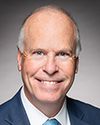I think that “lawfully obtained” shortens and, as you say, broadens the definition. There is still the practical barrier around how that's all obtained. I'm just going to get right into the specifics of it.
The John Deere X9 combine, for example, is set up so that part of the controller is on a header and part of it is now in the combine itself. Normally the controller is all in the combine, and then you have a cable running out through the feeder house to the front end, where the header would attach. Then the header manufacturer has their interface with the cabling that goes out to make the connection, and away it goes. The interface does the talking with the controller, and it's done.
However, the way that John Deere is now manufacturing products is that you have part of it here and part of it there. It's now a technical or physical lock as well that is now in between there, but through the Copyright Act, they're still able to hide and be able to lock John Deere off the platform, because they still can.... Honey Bee, for example, is not going to buy 70 different models from all the different manufacturers across the world. They testified about how they sell to 27 countries around the world. Some of those machines never make it to North America, so they're not actually going to be able to have the machine come to their shop and to reverse engineer it and do the thing.
A lot of it is dependent on companies just having a standardized electrical cabling system, but now you have a company that has gone beyond that and has reinvented the wheel, per se, and nobody else is allowed to have access to the reinvented wheel. This is what's happening, both physically and digitally. That's the barrier we're trying to prevent from becoming a more common practice, because as the rest of the OEMs see that John Deere can get away with it, they are going to start doing the same thing—monkey see, monkey do.
Again, whether it's Honey Bee or the tow-behind implements for planting and seeding, there are lots more short lines in the industry. The impacts are going to be realized by them in the not too distant future as well. Then the other industries, like mining and forestry, are going to see the impacts as well, as companies go to both physically and digitally locking out these other companies.
The reason we had the very specific exemption for manufacturers was that we think that under (a) we would be able to get somebody who is maybe not necessarily a manufacturer but is still trying to make a product. They would fall under proposed paragraph 41.12(1)(a), whereas proposed paragraph (b) would be very specific. The dictionary references a manufacturer as a corporate entity that makes a product. It's very specific about what they're talking about. It also recognizes that what we're trying to accomplish with some of the new wording that has been added to the other portions of the act is the aftermarket product that we're talking about here and being specific to.
I definitely appreciate the language that has been recommended through G-1. I just don't know that it's actually going to provide the certainty and clarity that industry is looking for, especially since a lot of this will be settled in court. That's the way a lot of this will work. At the end of the day, some of these big OEMs have a lot of power behind them, and nobody can withstand that legal challenge. We want to make sure we have absolute certainty and clarity within the act so that it's abundantly clear to the people who are trying to make these short-line products.
Again, there was a good study done by Western Economic Diversification Canada that speaks to the impacts that it has across the country. It's about making sure that those people have the jobs, but also the innovation that goes along with it, and about the benefit to small town and rural Canada all across this country.
I worry that by removing some of the specifics on the manufacturers exemption that we put in there, we're removing the clarity and certainty we were trying to achieve and obtain by putting forward the bill.
I agree with the language in proposed paragraph 41.12(1)(a). The way (a) and (b) are written, they make sense, but again, steering away from the actual intent of (b), as it was written in the draft of Bill C-294 originally, waters it down. It makes it a bit ambiguous, which opens the door for litigation to be levied against people who are trying to innovate.




